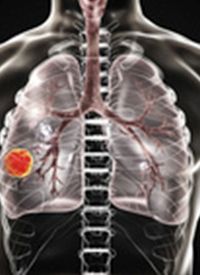Article
Telisotuzumab Vedotin Plus Erlotinib Shows Encouraging Activity in Advanced c-Met+ NSCLC
Author(s):
Telisotuzumab vedotin in combination with erlotinib induced promising outcomes in patients with advanced, EGFR-mutated, c-MET-positive non–small cell lung cancer who were contraindicated for surgery or other approved therapies.

Telisotuzumab vedotin (teliso-V) in combination with erlotinib (Tarceva) induced promising outcomes in patients with advanced, EGFR-mutated, c-MET-positive non–small cell lung cancer (NSCLC) who were contraindicated for surgery or other approved therapies, according to findings from a phase 1b study (NCT02099058).1
Investigators assigned 42 adults with c-MET-positive (confirmed histology score ≥ 150) 2.7 mg/kg telisotuzumab vedotin once every 21 days plus 150 mg erlotinib once daily. All 42 patients were included in the safety analysis; 36 were evaluable for efficacy.
The overall response rate (ORR) for all patients was 30.6% (95% CI, 16.3%-48.1%) and the disease control rate (DCR) was 86.1% (95% CI, 70.5%-95.3%). The ORR for EGFR-mutated patients (n = 28) was 32.1% (95% CI, 15.9%-52.4%). For c-MET high, EGFR-mutated patients (n = 15), the ORR was 52.6%.
The median progression-free survival (PFS) for all patients was 5.9 months (95% CI, 2.8-not reached [NR]). Duration of response was NR at the time of data cutoff. Median PFS was 6.8 months (95% CI, 4.3-NR) for patients with non-T790M mutated tumors and for those whose T790M status was unknown vs 3.7 months (95% CI, 1.4-NR) for those with T790M mutated tumors.
Investigators conducted radiographic tumor assessments via computed tomography or magnetic resonance imaging within 28 days of treatment initiation and once every 6 weeks thereafter. Assessments continued until documented disease progression, start of new anticancer therapy, death, or withdrawal of consent.
Investigators noted that patients often acquire resistance to EGFR TKIs because of the potential acquisition of resistance mutations and/or the aberrant activation of c-Met, a protein that promotes tumor development and progression. This study examined the safety, pharmacokinetics, and preliminary efficacy in patients with c-Met–positive NSCLC treated with the c-Met–targeting drug telisotuzumab vedotin in combination with the EGFR TKI erlotinib.
Eligible patients had to have archival tumor tissue available for biomarker analysis and confirmation of c-Met overexpression, MET exon 14 skipping mutations, or MET amplification, as determined by a central/local site laboratory. Later study protocol amendments required the patient’s tumor to have a deletion 19 or L858R EGFR activating mutation and to have previously progressed on an EGFR TKI. Patients also needed to have an ECOG performance status of 0 to 2 and adequate bone marrow, renal, and hepatic function.
Main exclusion criteria included any prior anti-cancer therapy, uncontrolled central nervous system metastases, or any medical condition that would put the patient at an unacceptably high risk for toxicity.
All patients were c-MET positive. Twenty-eight patients had EGFR-mutant disease, 5 had EGFR wild-type disease, and 3 had rare or unknown EGFR status. Among those with a confirmed EGFR mutation, 16 (44%) had Del19, 12 (33%) had L858R, and 2 (6%) had rare mutations.
The median patient age was 65 years (range, 34-80). Twenty-one (58%) patients were female. Thirty-five (97%) had nonsquamous disease.
Patients were heavily pretreated. Twenty-five (69%) previously received 3 or more prior lines of therapy. Thirty (83%) received a first-/second-generation EGFR TKI across all lines and 16 (44%) received a third generation EGFR TKI. Thirty-three percent received a third-generation EGFR TKI as their last prior therapy. Seventeen (47%) received at least 3 prior lines of treatment with an EGFR TKI.
All patients experienced at least 1 adverse event (AE), most commonly peripheral sensory neuropathy (43%), dermatitisacneiform (38%), diarrhea (33%), and hypoalbuminemia (33%). Twenty-seven (64%) patients experience grade 3 or higher AEs. Pulmonary embolism (14%) was the most common such AE, followed by hypokalemia (10%), and diarrhea, malignant neoplasm progression, peripheral sensory neuropathy, and hypophosphatemia (7% each).
Thirty-seven (88%) experienced treatment-related (TR) AEs. The most common any-grade TRAEs were peripheral sensory neuropathy (36%) and peripheral neuropathy (19%). Thirteen (31%) experienced grade 3 or higher TRAEs, most commonly hypophosphatemia and peripheral sensory neuropathy (7% each).
Serious AEs observed in at least 5% of patients included malignant neoplasm progression (7%),and pneumonia, dehydration, and pulmonary embolism (5% each). Three (7%) patients reported at least 1 serious TRAE including decreased appetite, dehydration, hemoptysis, peripheral neuropathy, and pneumonia (2% each).
In January 2022, the FDA granted a breakthrough therapy designation to telisotuzumab vedotin for patients with advanced or metastatic EGFR wild-type, nonsquamous NSCLC who have high levels of c-Met overexpression and whose disease has progressed on, or after, platinum-based chemotherapy. Findings from the ongoing phase 2 LUMINOSITY trial (Study M14-239; NCT03539536) showed that treatment telisotuzumab vedotin as a monotherapy in the second- or third-line setting elicited an ORR of 53.8%. The ORR was 25.0% in the subset of patients with intermediate c-Met expression.2
References
- Camidge DR, Barlesi F, Goldman JW, et al. Phase Ib study of telisotuzumab vedotin in combination with erlotinib in patients with c-met protein-expressing non-small-cell lung cancer. J Clin Oncol. Published online October 26, 2022. doi:10.1200/JCO.22.00739
- AbbVie announces US FDA granted breakthrough therapy designation (BTD) to telisotuzumab vedotin (teliso-V) for previously treated non-small cell lung cancer. News release. AbbVie; January 4, 2022. Accessed October 28, 2022. https://bit.ly/3eSQRpN








